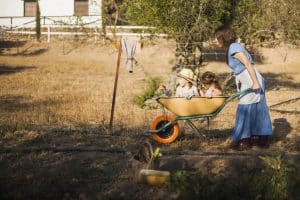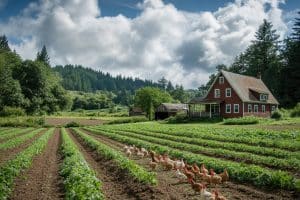Homestead core trend 2025: Embracing the future

Advertisement

In a world increasingly driven by fast consumption and digital dependence, the Homestead core trend emerges as a refreshing call to simplicity, resilience, and intentional living.
This aesthetic and lifestyle isn’t just a visual movement, it’s a full return to values centered on self-sufficiency, eco-consciousness, and meaningful connection with nature.
If you’re craving a slower, more grounded way of life without giving up on innovation, the Homestead core mindset might be exactly what your modern soul needs.
Understanding the Homestead Core Concept: A New Era of Intentional Living
To understand the Homestead core concept is to rediscover a lifestyle rooted in balance, sustainability, and meaningful connection.
Advertisement
More than just an aesthetic, Homestead core blends the beauty of rural life with conscious living, encouraging individuals to slow down, become more self-sufficient, and engage deeply with their surroundings.
Unlike fleeting trends, Homestead core is built on lasting values. It reflects a growing cultural shift where people are turning to nature, tradition, and craftsmanship as antidotes to overconsumption and disconnection.
It’s about cultivating not just your land, but also your habits, routines, and inner peace.
Advertisement
Inspired by cottagecore’s cozy visuals but grounded in real-world practices, Homestead core incorporates daily rituals such as gardening, preserving food, collecting rainwater, and decorating with reclaimed or handmade items.
This movement is tactile, intentional, and deeply satisfying.
Foundational Principles of the Homestead Core Lifestyle
The Homestead core lifestyle is guided by several fundamental principles that support a more resilient and sustainable way of living.
Focus on Local and Regenerative Food
Homesteaders grow their own fruits, vegetables, and herbs whenever possible. This reduces reliance on industrial agriculture, ensures fresher meals, and promotes a circular, waste-free kitchen.
Canning, fermenting, and seed-saving are common practices that reconnect people to the rhythm of nature.
Commitment to Renewable Energy and Efficiency
Homes inspired by Homestead core often feature solar panels, wood-burning stoves, or other low-impact energy solutions. The aim is to reduce consumption and environmental harm while building energy independence.
Even small changes, such as switching to LED lighting or using passive heating techniques, reflect this mindset.
Water Conservation and Land Stewardship
Capturing rainwater, installing drip irrigation, and growing native or drought-tolerant plants are core actions. These practices not only save water but also promote soil health and resilience during extreme weather conditions.
The homestead becomes a living ecosystem, where every resource is valued and reused.
Respect for Biodiversity and Seasonal Living
By integrating diverse crops, pollinator-friendly plants, and natural pest control methods, Homestead core supports biodiversity.
Seasonal living means eating what is in season, preserving harvests, and adapting your routine to the environment rather than controlling it.
The Role of Community in the Homestead Core Lifestyle
A central part of the Homestead core trend is the strong sense of community it fosters. Homesteading is not a solitary pursuit. Many followers of this lifestyle engage in local seed swaps, attend farmers’ markets, or join cooperative gardens.
These shared experiences offer more than practical benefits. They build trust, encourage intergenerational knowledge exchange, and reinforce a collective commitment to sustainability.
From trading sourdough starters to sharing tools and labor, community bonds become a vital resource.
Being part of a homesteading network allows for collaboration and emotional support, especially as more people seek alternatives to consumer-driven culture.
This collective mindset strengthens both individual homes and the larger ecosystem of intentional living.
Living with Purpose and Planet in Mind
At its core, the Homestead core concept invites you to live with purpose, not perfection. It’s about making mindful choices that respect the planet, enhance your well-being, and bring a sense of harmony to your daily life.
Whether you have a backyard garden or a city balcony, embracing this concept means stepping into a lifestyle where small, thoughtful actions have a lasting impact.
By prioritizing quality over quantity, connection over convenience, and sustainability over speed, you begin to cultivate a life that truly feels like home.
Defining Features of the Homestead Core Trend in 2025
The Homestead core trend in 2025 reflects a significant cultural shift toward sustainability, authenticity, and slower living. This lifestyle is no longer limited to countryside dwellers or off-grid communities.
It has grown into a movement that blends self-sufficiency, environmental responsibility, and emotional well-being in both rural and urban settings.
Driven by climate concerns, digital fatigue, and the desire for a more rooted way of life, the trend highlights how people are choosing to build environments that nourish rather than deplete.
In 2025, Homestead core is being redefined by key pillars that fuse tradition with innovation.
1. Sustainable Living as a Foundation
At the heart of the 2025 Homestead core trend is a renewed commitment to sustainability. People are turning away from disposable habits and embracing regenerative practices that honor the natural world.
- Organic gardening has become a cornerstone, with more individuals choosing to grow their food using compost, companion planting, and soil-enriching techniques.
- Permaculture is now widely applied in backyard design, encouraging harmonious layouts that maximize yield while minimizing environmental disruption.
- Rainwater harvesting systems and greywater reuse are gaining popularity, ensuring that every drop is used wisely.
- Daily zero-waste habits, such as bulk shopping, reusing glass jars, and making DIY cleaning products, are becoming second nature to homesteaders of all kinds.
These practices not only lower environmental impact but also foster independence and a deeper appreciation for seasonal rhythms.
2. Emphasis on Technology
One of the most exciting evolutions of Homestead core in 2025 is the integration of smart technology with traditional homesteading skills.
Far from being at odds, digital tools are enhancing efficiency, making homesteading more accessible and manageable, even for beginners.
- Smart irrigation systems and app-controlled greenhouses help manage crops remotely and conserve water more effectively.
- Solar panels and energy-monitoring devices are increasingly standard in homestead-style homes, reducing carbon footprints while lowering utility costs.
- Mobile apps now support everything from planting calendars to animal health tracking, allowing homesteaders to make data-informed decisions.
- Energy-efficient kitchen appliances and heat-retaining materials are replacing high-consumption items, aligning with Homestead core’s minimalist yet functional design ethos.
By combining modern tools with timeless skills, homesteaders are showing that progress and simplicity can coexist beautifully.
3. Community Engagement
Community plays a vital role in the homestead core trend. Many individuals are forming groups to share resources and knowledge. This collaboration fosters a sense of belonging.
Participating in local farmers’ markets or community gardens allows homesteaders to connect with others who share similar values. These interactions can lead to enriched experiences and support systems that facilitate growth.
In 2025, Homestead core is more than a back-to-basics lifestyle. It represents a conscious decision to live with less waste, more intention, and stronger relationships.
Through sustainable practices, smart tools, and community engagement, this trend is shaping how people build their homes, nourish their bodies, and connect to the world around them.
How to adapt your homestead for sustainability

Adapting your homestead for sustainability is not only a responsible decision in today’s climate-conscious world, but also a rewarding one.
Embracing the Homestead core lifestyle means creating a home that aligns with nature, prioritizes resourcefulness, and reduces environmental impact.
Whether you’re just starting out or refining your practices, making thoughtful changes in key areas of your homestead can foster a healthier relationship with the planet.
1. Grow Your Own Food
One significant step is to grow your own food. This not only saves money but also reduces transportation emissions linked to store-bought produce. Consider starting with:
- Vegetable gardens in your backyard.
- Herb gardens on windowsills or balconies.
- Fruit trees or berry bushes that flourish in your climate.
- Composting to enrich your soil and minimize waste.
Producing your own food connects you to the earth and enhances your self-sufficiency.
2. Utilize Renewable Energy
Incorporating renewable energy sources can dramatically reduce your carbon footprint. Installing solar panels or small wind turbines can provide sustainable energy for your homestead. These technologies often pay for themselves over time through significant energy savings.
Please ensure to evaluate your energy needs first. This allows you to choose the right system. Many homeowners find that combining these sources leads to greater efficiency and resilience.
3. Water Conservation Strategies
Water conservation is vital for sustainability. You can implement rainwater harvesting systems to collect water for your garden and home.
Additionally, consider using drip irrigation systems. These methods optimize water use while supporting your plants’ health.
Choose drought-resistant plants to reduce water dependence. This approach not only conserves this precious resource but also ensures your garden thrives, even during dry spells.
By approaching sustainability as a long-term commitment, you transform your home into a living system that supports both personal well-being and environmental health.
The Homestead core trend is about more than growing vegetables or installing solar panels. It’s about aligning your daily habits with your values and creating a space where every choice supports a more intentional and regenerative way of life.
Benefits of urban homesteading practices
Urban homesteading practices offer numerous benefits for city dwellers seeking a more sustainable lifestyle. These practices allow individuals to reclaim their connection to nature, even in metropolitan areas.
1. Fresh and Healthy Food
One major advantage of urban homesteading is access to fresh and healthy food. By growing your own fruits and vegetables, you can ensure they are free from harmful pesticides and chemicals.
- Homegrown produce is often tastier than store-bought.
- Gardening promotes physical activity and mental well-being.
- It can lower your grocery bills significantly.
- Seasonal eating encourages creativity in cooking.
These benefits translate into a healthier lifestyle for you and your family.
2. Environmental Impact
Another benefit is the positive environmental impact of urban homesteading. By adopting sustainable practices, you can reduce your carbon footprint. Small actions make a big difference when many people participate.
Flying less food in from distant locations supports local ecosystems. Additionally, creating green spaces in urban settings helps combat air pollution and provides habitats for wildlife.
3. Community Connection
Urban homesteading also fosters a sense of community. Many urban homesteaders connect with neighbors through shared gardening projects, workshops, or farmer’s markets.
This interaction helps build friendships and encourages sharing resources. Joining local groups can enhance your experience as you learn from others who share your goals.
As you can see, engaging in urban homesteading practices can lead to significant improvements in personal health, environmental sustainability, and community bonds.
These practices not only benefit the individual but also contribute to a more resilient urban environment as a whole.
Future Predictions for Homesteaders: Innovation Rooted in Self-Sufficiency

As the Homestead core trend continues to shape how people live, grow, and connect, the future points to an evolution where technology, collaboration, and ecological wisdom walk hand in hand.
Homesteading is no longer limited to remote farms or off-grid cabins. It is becoming a dynamic lifestyle embraced by those seeking deeper connection with nature and greater autonomy in everyday life.
In the coming years, this movement is expected to grow in scale, impact, and accessibility.
Smart Tools and Technological Integration
The future of homesteading involves the seamless integration of technology into everyday routines.
While the heart of Homestead core lies in traditional values, digital tools are increasingly being used to support efficiency and reduce manual workload.
Smart irrigation systems, soil and moisture sensors, and mobile apps for planting schedules or livestock care are becoming part of the modern homesteader’s environment.
These innovations allow individuals to optimize time, conserve resources, and scale their efforts sustainably. Technology won’t replace the soul of homesteading, but it will help preserve it by making it more viable in a modern context.
🤝 A Stronger Focus on Community Collaboration
Another future shift is the deepening of community connections. As climate concerns grow and local networks become more vital, homesteaders are expected to move further toward collective action.
From shared gardens and resource libraries to collaborative food co-ops and hands-on workshops, the Homestead core lifestyle is set to thrive through cooperation.
These networks will serve not only as practical support systems but also as emotional anchors, giving individuals the sense of belonging and purpose that often gets lost in urbanized, disconnected living.
🌱 Evolving Sustainable Practices and Ecological Stewardship
The next phase of Homestead core will be defined by more advanced sustainability practices.
Regenerative agriculture will take center stage, focusing on restoring soil health, increasing biodiversity, and working with natural systems instead of against them.
Homesteaders are also expected to embrace heirloom seed cultivation, native planting, and habitat conservation as part of their regular land care.
This represents a deeper, more conscious engagement with the environment, moving beyond basic organic gardening into full ecological stewardship.
In summary, the future of homesteading is not about turning away from progress, but about aligning it with purpose.
The Homestead core trend will continue to evolve, blending ancient wisdom with modern tools, personal independence with collective strength, and environmental responsibility with everyday practicality.
This lifestyle is proving to be not just a return to the past, but a sustainable way forward.
Final Thoughts: A Return to Rooted Living
The Homestead core trend in 2025 is more than a fleeting aesthetic, it’s a purpose-driven lifestyle that prioritizes simplicity, self-reliance, and environmental awareness.
As the world moves faster and becomes more complex, Homestead core offers an intentional pause, a return to what truly matters.
Whether you’re living in the countryside or adapting to urban homesteading, embracing the Homestead core lifestyle means reconnecting with nature, cultivating resilience, and building stronger community ties.
It encourages you to grow your own food, reduce waste, harness clean energy, and make your home a sanctuary that reflects values over vanity.
More importantly, Homestead core is about empowerment. It gives individuals the tools to take control of their routines, support local ecosystems, and find meaning in everyday rituals.
With its grounding philosophy, the Homestead core trend empowers a new generation to live more mindfully, without losing the benefits of modern life.
Ready to dive deeper into this fulfilling lifestyle? Explore beautiful examples and actionable ideas through these resources:
Homestead core is not just a movement, it’s a mindset. It’s how we heal our spaces, our habits, and our homes. By embracing the Homestead core trend, you’re choosing a life that’s slower, wiser, and ultimately more rewarding.
FAQ – Frequently Asked Questions about Homesteading
What is urban homesteading?
Urban homesteading is the practice of cultivating a self-sufficient lifestyle in an urban environment. It involves growing food, raising animals, and practicing sustainability.
How can technology help in homesteading?
Technology, such as smart gardening tools and monitoring systems, can improve efficiency, optimize crop yields, and help manage resources effectively.
What are the benefits of growing your own food?
Growing your own food provides fresh, healthy produce while reducing reliance on store-bought items. It also saves money and promotes physical activity.
Why is community important in homesteading?
Community engagement fosters collaboration, knowledge sharing, and support among homesteaders. It enriches the experience and builds resilient local networks.
Liked the article?





